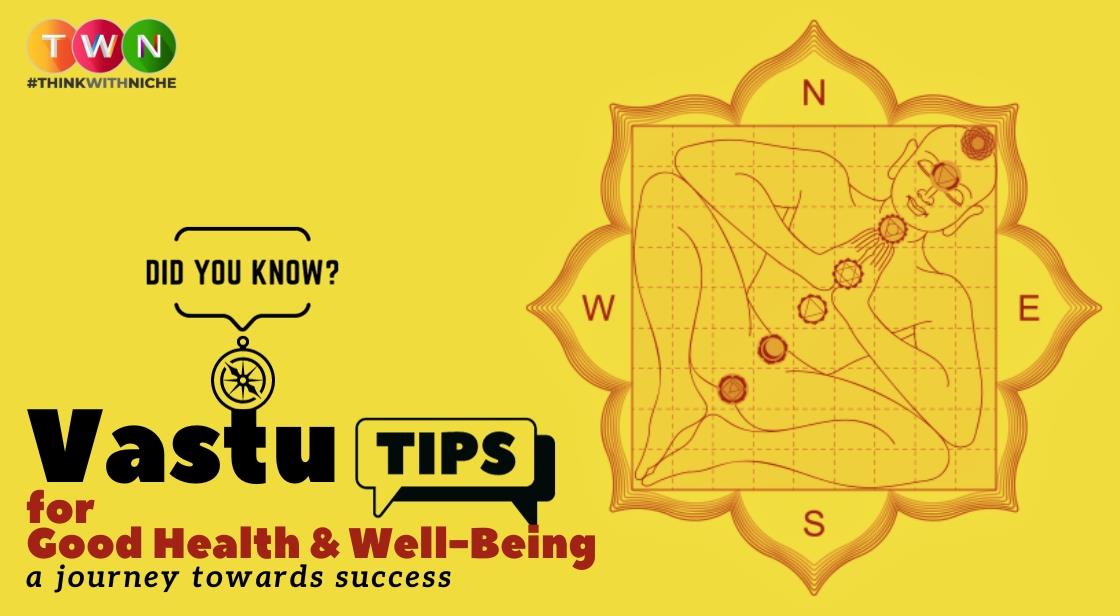Vastu Tips for Good Health and Well-Being

Blog Post
The pursuit of good health and overall well-being transcends cultural and geographical boundaries, and the ancient Indian science of Vastu Shastra offers timeless guidance on how the environment we inhabit can influence our physical and mental health.
Vastu Shastra, commonly known as "Vastu," stands as an age-old Indian architectural and design science, offering a set of principles that guide the planning, layout, and organization of living spaces.
Deeply ingrained in Indian heritage, it is upheld as a belief system thought to significantly influence the welfare, balance, and affluence of individuals and households.
In this article, we explore key Vastu tips that encompass various aspects of your home environment, offering a holistic approach to nurturing health and fostering serenity.
The versatility of this Vastu tip allows it to be applied in various settings, from traditional study rooms to modern home offices.
While embracing Vastu's age-old wisdom in the pursuit of health and well-being, it's essential to find a balance between these ancient principles and modern living.
By understanding the principles behind these Vastu tips and creatively adapting them to contemporary lifestyles, individuals can create living spaces that resonate with positive energies, fostering a sense of peace, balance, and overall well-being.
Achieving good health and overall well-being involves a holistic approach, and Vastu Shastra, the ancient Indian science of architecture, plays a crucial role in creating harmonious living spaces. Explore the following Vastu tips that encompass key aspects of your home environment, promoting physical and mental wellness.
In the quest for a fulfilling life, the significance of health and well-being cannot be overstated. Vastu Tips, rooted in ancient Indian wisdom, offer actionable insights to enhance the positive energies in your living spaces. From the arrangement of furniture to the use of colors, these tips are designed to create a conducive environment for a healthier and more balanced lifestyle.
What is Vastu shastra ?
Vastu Shastra, often referred to as simply "Vastu," is an ancient Indian science of architecture and design that encompasses principles for the construction, layout, and arrangement of living spaces. It is deeply rooted in Indian culture and tradition and is believed to have a profound impact on the well-being, harmony, and prosperity of individuals and families.
The term "Vastu" is derived from the Sanskrit word "Vastu", which means "site" or "dwelling place." Vastu Shastra provides guidelines and recommendations for creating living and working environments that are in harmony with the natural forces and energies, both physical and metaphysical. It aims to establish a balanced relationship between the built environment and the cosmic energies, promoting a sense of peace and prosperity.
Key principles of Vastu Shastra
Key principles of Vastu Shastra include the orientation of buildings, the placement of rooms and objects, and the use of specific materials, colors, and designs. The primary goal of Vastu is to ensure the well-being, health, and success of the occupants by aligning the living or working space with the natural elements, cardinal directions, and universal energies.
Vastu Shastra is widely applied in the design and construction of homes, offices, temples, and other structures in India and has gained attention in other parts of the world as well. While many people adhere to Vastu principles, it is essential to note that its practice is a matter of belief and tradition, and its effectiveness varies from person to person.
Vastu Tips for Good Health and Overall Well-Being
# Light a Lamp in the Northeast for Good Health:
Vastu Shastra, the ancient Indian science of architecture, delves into the harmonious alignment of spaces to enhance well-being. One powerful Vastu tip for promoting good health involves lighting a lamp or candle in the northeast direction of your home.
Understanding the Significance:
-
Northeast Direction: According to Vastu principles, each direction carries specific energies. The northeast is associated with the water element, symbolizing purity and tranquility. Aligning activities with this direction is believed to attract positive vibrations.
-
Symbolism of Light: Light is a universal symbol of positivity and dispelling darkness. When a lamp is lit, it not only illuminates the physical space but also represents dispelling ignorance and ushering in wisdom.
Implementation and Examples:
-
Choose a Small Lamp or Candle:
-
Opt for a small, aesthetically pleasing lamp or candle.
-
Consider traditional lamps like diyas for cultural resonance.
-
-
Placement in the Northeast:
-
Identify the northeast corner of your home, ensuring the lamp is placed there.
-
Be mindful of not obstructing the natural flow of energy in this direction.
-
-
Promoting Serenity:
-
Lighting a lamp in the northeast brings a sense of serenity to the space.
-
It can be part of your daily routine, contributing to a mindful and peaceful environment.
-
Scientific Perspective:
-
Circadian Rhythms: Exposure to natural light, especially in the morning, positively influences circadian rhythms, which regulate sleep and wake cycles.
-
Psychological Impact: The act of lighting a lamp in the morning can have psychological benefits, creating a positive start to the day.
Examples of Implementation:
-
Traditional Practices:
-
Many households in India traditionally light lamps during morning prayers, aligning with cultural and Vastu practices.
-
-
Contemporary Adaptations:
-
Modern lamp designs can seamlessly integrate with contemporary home decor while honoring Vastu principles.
-
# Repair Leaking Taps
In the realm of Vastu for good health, the seemingly mundane aspects of our homes, such as leaking taps, can play a crucial role. This second Vastu tip emphasizes the importance of promptly repairing any leaking taps to safeguard both physical well-being and overall life harmony.
Understanding the Significance:
-
Energetic Flow: Vastu considers the flow of energy within a space. Leaking taps are seen as disruptions in this flow, potentially impacting the overall energetic balance of the home.
-
Water Element: In Vastu, water is associated with wealth and prosperity. A leaking tap symbolizes a wastage of this precious resource, aligning with the belief that neglecting resources can negatively influence health.
Implementation and Examples:
-
Immediate Repairs:
-
Act promptly to fix any leaking taps as soon as you notice them.
-
Regularly check for and address plumbing issues to prevent prolonged leaks.
-
-
Noise Pollution:
-
Beyond the physical aspect, the consistent sound of dripping water can contribute to stress and disturb the peaceful ambiance of your home.
-
-
Symbolism of Abundance:
-
Repairing leaks aligns with the symbolism of abundance and not allowing valuable resources to go to waste.
-
Scientific Perspective:
-
Mold and Dampness: Leaks can lead to dampness and mold, which are known to have adverse health effects, especially on respiratory health.
-
Psychological Impact: Living in a well-maintained environment positively impacts mental well-being, contributing to a sense of order and control.
Examples of Implementation:
-
Timely Maintenance:
-
Homeowners practicing Vastu often integrate regular checks for leaks into their home maintenance routines.
-
-
Modern Solutions:
-
Advanced plumbing solutions, like leak detection systems, can be employed to identify and address leaks proactively.
-
Also Read : Vastu Shastra Tips for Building a Harmonious Home
# Avoid Using the Space Under the Stairs
In the intricate principles of Vastu for good health, the utilization of every space in a home is believed to have specific consequences on well-being. The third Vastu tip advises against using the space under the stairs, associating it with potential health issues and heart-related concerns. Understanding and respecting this recommendation involves delving into both traditional beliefs and practical applications.
Understanding the Significance:
-
Energies and Directions:
-
Vastu Shastra assigns energies to different directions. The space under the stairs is often considered inauspicious, holding energies that may adversely affect health.
-
-
Symbolism of Weight:
-
Metaphorically, the weight of the staircase above could be symbolically associated with the burden on one's health, especially the heart.
-
Implementation and Examples:
-
Clutter-Free Zone:
-
According to Vastu, clutter accumulates negative energy. Keeping the space beneath the stairs clean and clutter-free is essential.
-
-
Alternative Usage:
-
If possible, consider alternative uses that align with positive energies, such as creating a small puja space or placing decorative items.
-
Modern Perspective:
-
Space Utilization:
-
From a modern perspective, utilizing the space under the stairs for storage or functional purposes is a common practice in interior design.
-
-
Psychological Impact:
-
While Vastu focuses on energy flow, modern psychology recognizes that the aesthetics and functionality of a space can influence mental well-being.
-
Examples of Implementation:
-
Decorative Elements:
-
Incorporate aesthetically pleasing elements such as plants, artwork, or lighting to enhance the space positively.
-
-
Functional Spaces:
-
Modern homes often convert the area under the stairs into functional spaces like a home office, reading nook, or storage area, aligning with contemporary design principles.
-
Harmony and Well-Being:
In interpreting Vastu for good health, it's crucial to strike a balance between traditional beliefs and modern lifestyles. While respecting the traditional advice about the space under the stairs, individuals can find creative and practical ways to harmonize the energy of their living spaces with their well-being, thus embodying the essence of Vastu in a contemporary context.
# Optimal Bedroom Placement – The Power of Southwest Direction
In the domain of Vastu for good health, the strategic placement of your bedroom is accorded significant importance. According to Vastu principles, locating the bedroom in the southwest direction is believed to exert positive influences on both physical and mental well-being.
Understanding the Significance:
-
Cosmic Energies:
-
Vastu Shastra posits that each direction is associated with specific cosmic energies. The southwest direction is considered to be imbued with stabilizing and grounding energies, promoting a sense of security and tranquility.
-
-
Balancing Elements:
-
Southwest is linked with the earth element, and aligning your bedroom in this direction is believed to create a harmonious balance of natural forces, fostering good health.
-
Implementation and Examples:
-
Bed Placement:
-
Align the bed in such a way that your head points towards the south while sleeping. This orientation is thought to enhance the quality of sleep and contribute to overall health.
-
-
Avoidance of Clutter:
-
Vastu advises keeping the southwest corner of the bedroom clutter-free. This decluttering practice is believed to allow the free flow of positive energy.
-
Modern Perspective:
-
Biophilic Design Considerations:
-
Aligning the bedroom with the southwest direction aligns with the principles of biophilic design, emphasizing connections with nature for improved well-being.
-
-
Stress Reduction:
-
A well-placed bedroom, according to Vastu, may contribute to stress reduction and the creation of a calming environment, which resonates with contemporary wellness design concepts.
-
Examples of Implementation:
-
Furniture Arrangement:
-
Place heavy furniture or elements in the southwest part of the bedroom to anchor the space and enhance the grounding effect.
-
-
Color Palette Choices:
-
Opt for earthy and calming color palettes for bedroom decor, aligning with the southwest direction’s grounding attributes.
-
Harmony and Well-Being:
Incorporating Vastu tips for good health, particularly in bedroom placement, allows individuals to weave traditional wisdom into the fabric of modern living. The southwest direction's influence, as per Vastu principles, may contribute to a balanced and health-enhancing environment, fostering a sense of peace and well-being in the intimate spaces of one's home.
# Optimizing Kitchen Energies:
In the realm of Vastu Shastra, the kitchen is regarded as a pivotal space where the energies that nurture life are harnessed. Here are insights into how Vastu principles can be applied to enhance the health-centric attributes of the kitchen:
-
Strategic Southwest Placement:
-
Vastu recommends situating the kitchen in the Southwest direction of the house. This direction is associated with the earth element, believed to instill stability and nourishing energies into the food preparation process.
-
-
Example:
-
Design Configuration: Arrange the kitchen layout so that major activities, such as cooking and food storage, align with the Southwest direction. This can be conducive to creating a grounded and harmonious culinary space.
-
-
Stove Placement in the East:
-
When the Southwest placement is not feasible, aligning the stove in the East is an alternative. This is a practice to honor Agni, the God of Fire, as per Vastu tradition.
-
-
Example:
-
Symbolic Orientation: Position the stove in the East direction and incorporate elements that represent the essence of fire, such as warm color schemes or decorative motifs inspired by flames.
-
-
Separation of Kitchen and Bathroom:
-
Vastu emphasizes the segregation of the kitchen and bathroom within the home. Placing them on the same wall frame is discouraged to prevent the clash of energies associated with these two vital spaces.
-
-
Example:
-
Design Layout: In architectural planning, ensure that the kitchen and bathroom are located on different walls to maintain energetic balance. This may involve careful spatial organization during construction or renovation.
-
Modern Considerations and Insights:
-
Efficient Work Triangle:
-
Integrating Vastu principles with modern design concepts, consider establishing an efficient work triangle in the kitchen layout. This ensures smooth flow and functionality.
-
-
Ventilation and Lighting:
-
In contemporary kitchen design, prioritize natural lighting and effective ventilation, aligning with Vastu's focus on the importance of light and air circulation for a healthy environment.
-
Harmony in Culinary Spaces:
By incorporating Vastu wisdom into kitchen design, individuals can create spaces that resonate with positive energies and contribute to overall well-being. Whether it's strategic placement or mindful orientation of elements, these practices, rooted in ancient knowledge, continue to offer valuable insights for harmonizing living spaces.
# Harmonizing Bedrooms: Vastu Caution on Mirrors
Vastu Tips for Good Health extend to the bedroom, emphasizing the strategic placement of elements to ensure a serene and health-promoting environment. Here’s an exploration of why Vastu discourages placing mirrors in front of beds:
Energy Reflections and Disturbances:
-
According to Vastu principles, mirrors have the capacity to reflect and amplify energies. Placing a mirror directly in front of the bed is believed to create energetic disturbances during sleep.
Example:
-
Optimal Placement: Instead of having a mirror facing the bed, consider positioning it on a side wall. This way, it reflects the space without directly impacting the bed's energetic dynamics.
Health Implications and Nightmares:
-
Vastu associates the placement of mirrors in front of beds with potential health troubles and disturbances in the form of nightmares. It is believed to affect the quality of sleep and mental well-being.
Example:
-
Alternative Placement: If a mirror is integral to the room's design, consider relocating it to a position where it doesn't directly reflect the bed. This adjustment aligns with Vastu principles while maintaining aesthetic considerations.
Mitigating Negative Energies:
-
Vastu recommends creating a bedroom environment conducive to positive energies and restful sleep. Avoiding direct mirror reflections on the bed is seen as a measure to mitigate any negative impacts on health.
Example:
-
Decorative Solutions: Explore alternative ways to integrate mirrors into bedroom decor, such as placing them on wardrobe doors or incorporating them into vanity areas, while still adhering to Vastu guidelines.
Modern Interpretations and Design Harmony:
-
Mirrored Furniture Considerations:
-
In modern interior design, mirrored furniture is a popular choice. To align with Vastu principles, ensure that such elements are strategically placed to avoid direct reflections on the bed.
-
-
Aesthetic Integration:
-
Designing bedrooms with Vastu in mind doesn't mean compromising on aesthetics. Mirrors can still be utilized as decorative elements, respecting guidelines to maintain a harmonious and health-promoting space.
-
# Vastu Wisdom on Air-Purifying Plants
In the realm of Vastu Tips for Good Health, the placement of air-purifying plants emerges as a significant practice for fostering well-being. Delving into this guidance reveals the principles behind it:
Positive Energy Infusion:
-
Vastu philosophy suggests that certain plants possess the ability to purify the air and emanate positive energy. Incorporating air-purifying plants contributes to a healthier living environment.
Example:
-
Tulsi (Basil): Revered for its medicinal and spiritual significance, Tulsi is a Vastu-recommended plant. Its air-purifying properties align with the goal of fostering a positive and health-promoting atmosphere.
Avoidance of Certain Plants:
-
Vastu cautions against the placement of specific plants, such as cactus, bonsai, and rubber plants, due to their perceived potential to introduce negative energies or cause illnesses.
Example:
-
Cactus: While appreciated for their resilience, cacti are advised against in Vastu due to their thorny nature. Vastu encourages plants with softer and rounded leaves for a more harmonious energy flow.
Strategic Placement:
-
The choice of where to place air-purifying plants is crucial. Vastu recommends situating them in areas where individuals spend significant time, such as the living room or bedrooms, to maximize their positive impact.
Example:
-
Living Room Foliage: Positioning air-purifying plants in the living room enhances the overall energy of the space, contributing to a sense of well-being for residents and visitors alike.
Aesthetic Integration:
-
Vastu principles seamlessly integrate with modern design aesthetics. Incorporating air-purifying plants not only aligns with health-oriented Vastu goals but also adds a touch of nature and greenery to interior spaces.
Example:
-
Decorative Planters: Explore creative and aesthetically pleasing planters that complement the overall design of the space. This approach allows for a harmonious fusion of Vastu wisdom and contemporary design sensibilities.
Promoting Holistic Well-Being:
-
Beyond their air-purifying benefits, plants contribute to a holistic sense of well-being. Vastu Tips for Good Health recognize the interconnectedness of physical and environmental factors in promoting health.
Example:
-
Wellness Corners: Designate specific corners in rooms for clusters of air-purifying plants, creating wellness corners that align with Vastu principles and elevate the overall ambiance.
# Aligning Learning Spaces: Vastu Insights for Optimal Health
In the realm of Vastu Tips for Good Health, the guidance to face the north while studying carries profound implications for energy flow and positive outcomes in academic pursuits. Unpacking this recommendation reveals the underlying principles:
Energy Channeling Through Direction:
-
Vastu, rooted in ancient Indian architectural wisdom, posits that each direction is associated with specific energies. Facing east or north while studying is believed to align the learner with positive cosmic energies, facilitating a conducive environment for focused and effective study sessions.
Example:
-
Natural Light in the North: Orienting study spaces to face north allows for optimal utilization of natural light during daytime, positively impacting the overall study experience. Exposure to natural light is linked to improved mood and concentration.
Enhancing Concentration and Focus:
-
Vastu Tips for Good Health often emphasize the mind-body connection. Facing north or east while studying is thought to enhance concentration and focus, creating an environment where learning becomes more effective and enjoyable.
Example:
-
Placement of Study Desk: Positioning the study desk in a way that aligns with the recommended directions contributes to a harmonious study environment. This can involve adjusting the orientation of furniture to maximize the benefits of directional alignment.
Circulation of Positive Energies:
-
The directional alignment is linked to the circulation of positive energies in the learning space. By facing north or east, learners are believed to tap into a conducive energy flow that supports cognitive processes and mental well-being.
Example:
-
Mindful Furniture Arrangement: Implementing Vastu-aligned furniture arrangements ensures that the flow of energy in the room is unobstructed. This can include placing desks, chairs, and study materials in a way that promotes a seamless energy circulation.
Adaptability to Various Spaces:
-
The versatility of this Vastu tip allows it to be applied in diverse settings, from traditional study rooms to modern home offices. The fundamental principle is to align the study space with the cardinal directions, irrespective of the architectural context.
Example:
-
Virtual Learning Environments: In the era of virtual learning, individuals can adapt this Vastu principle by positioning their study setups to face north or east even within digital spaces. Virtual backgrounds or desk arrangements can be curated with this in mind.
Modern Application in Interior Design:
-
Contemporary interior design often integrates Vastu principles for a holistic living experience. In aligning study spaces with north or east directions, individuals can seamlessly merge ancient wisdom with modern aesthetics.
Example:
-
Aesthetic Study Nooks: Designing aesthetically pleasing study nooks that adhere to Vastu principles contributes to an overall positive ambiance. Integrating directional alignment into design choices enhances both functionality and visual appeal.
Navigating Vastu Challenges: Things to Avoid for Optimal Health
While Vastu Tips for Good Health provide valuable insights for enhancing well-being, it is equally crucial to be mindful of certain practices to avoid, as suggested by Vastu principles. Delving into these recommendations reveals the rationale behind each guideline:
Electronic Devices in Bed Storage:
-
Challenge: Storing electronic devices in bed storage boxes.
-
Why to Avoid: Vastu cautions against keeping electronic devices in the bed storage box, linking it to potential heart problems and mental instability.
-
Modern Consideration: Excessive exposure to electronic devices, especially before bedtime, is associated with sleep disturbances and mental health concerns. It aligns with Vastu advice to keep the sleep environment free from electronic clutter.
Kitchen in the Northeast Direction:
-
Challenge: Constructing the kitchen in the Northeast direction.
-
Why to Avoid: Vastu attributes potential health complications to kitchens located in the Northeast, emphasizing the need to choose alternative directions.
-
Modern Consideration: Contemporary architectural designs often prioritize functional and aesthetic kitchen layouts. Adapting Vastu principles may involve exploring alternative directions while ensuring efficient and hygienic kitchen spaces.
Clutter in the Northeast Area:
-
Challenge: Clutter or heavy objects in the Northeast area of the house.
-
Why to Avoid: Vastu underscores the importance of maintaining a clutter-free Northeast area for the overall health of the family, associating clutter with disruptive energies.
-
Modern Consideration: Mindful decluttering aligns with modern organizational practices, promoting a serene living environment. Integrating this Vastu advice supports a balanced and harmonious home.
Proximity of Kitchen and Toilet:
-
Challenge: Lack of distance between the kitchen and toilet.
-
Why to Avoid: Vastu suggests maintaining a distance between the kitchen and toilet to prevent conflicting energies.
-
Modern Consideration: Ensuring a reasonable distance between these spaces acknowledges the importance of hygiene and energy flow. Modern architectural planning incorporates such considerations for holistic living.
Bedroom in the Northeast Direction:
-
Challenge: Having the bedroom in the Northeast direction.
-
Why to Avoid: Vastu warns against placing bedrooms in the Northeast, linking it to potential severe health issues.
-
Modern Consideration: Contemporary interior design principles align with the idea of creating tranquil bedroom spaces. Adapting Vastu guidelines involves choosing alternative directions without compromising comfort and aesthetics.
Sleeping Under a Beam:
-
Challenge: Sleeping under a beam.
-
Why to Avoid: Vastu advises against sleeping under a beam, associating it with the potential to trigger anxiety and depression.
-
Modern Consideration: Interior design trends favor open and spacious layouts. Avoiding sleeping under a beam resonates with the modern preference for unobstructed and calming sleep environments.
Conclusion
Vastu Shastra, also known as Vastu, is a venerable Indian science that provides a structured framework for creating harmonious living environments.
Rooted in tradition and culture, it has endured through the ages, believed to impact the overall well-being and prosperity of those who embrace its principles.
By harmonizing architectural design with cosmic energies, Vastu offers a holistic approach to achieving physical and mental wellness within one's living spaces.
Whether it's optimizing the placement of a lamp for good health, creating clutter-free zones, or aligning study spaces with the cardinal directions, Vastu presents timeless wisdom that seamlessly integrates with modern design sensibilities.
This enduring science reminds us that the spaces we inhabit are not just physical structures but integral components of our journey towards health and holistic well-being.
You May Like
EDITOR’S CHOICE












